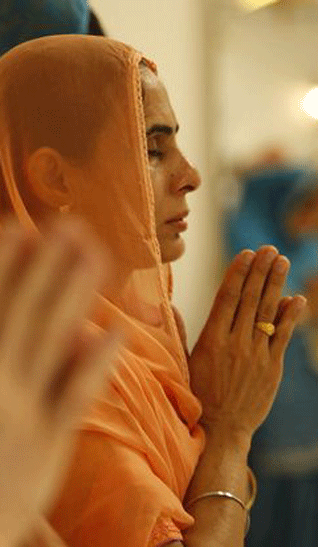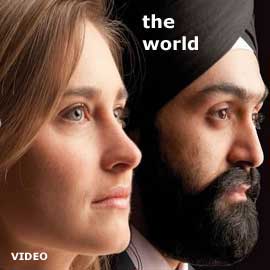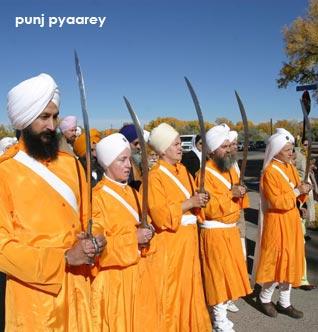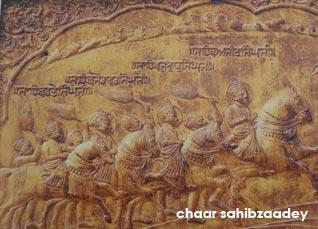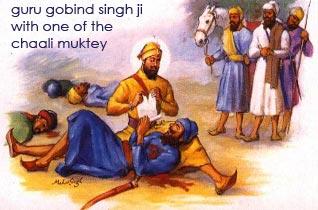Columnists
Punj Pyaarey, Chaar Sahibzaadey
Ardaas Part III
The Talking Stick Colloquium # 35, Nov 8 - 14
Convenor: RAVINDER SINGH TANEJA
THE DIALOGUE - So Far
We concluded our discussion last week with a consideration of the first passage of the Ardaas. The discussion on 'Bhagauti' should dispel any notion that the Sikh Ardaas begins with a summons to the goddess Durga. Clearly, the Gurus have used the existing cultural context (epics, legends, myths, etc.) to convey a singular message: that the One essence (Akal Purakh) permeates everything and it is to this power alone that a Sikh must connect to - as provider, sustainer and nourisher.
Several questions raised by readers remain unanswered and perhaps do not have a final answer. But we will continue to ponder them as we proceed.
THIS WEEK
This week we move on to the next passage in our Ardaas, which runs thus:
Punjaa(n) pyaareaa(n), chauhaa(n) Sahibzaad-eaa(n), chaalee mukte-aa(n), hutthee-aa(n), juppee-aa(n), tuppee-aa(n) ... **
[** In dwelling on this passage, it became increasingly evident and compelling that we need to pause - even at the cost of a slight digression - and reflect on the iconic figures mentioned as well as the institutional implications, particularly around the Punj Pyaarey. Accordingly, we will take up the remainder of the passage, from "Jinaa(n) naam jap-eaa ... " with next week's discussion.]
The Ardaas now moves from invoking the Tenth Master and the Eternal Guru, Guru Granth Sahib (lines 7 -10 which we did not specifically consider last week but which were later appended to the ardaas) to hailing the Guru and the Way of the Guru (Guru Panth) by celebrating the exemplars who walked the Way - the Punj Pyaarey, Chaar Sahibzaade, Chaali Muktey, and the Hutthee, Juppee and Tuppee.
We noted last week that the double edged sword, Khanda, represents Akal Purukh's transcendence as well as immanence. In our discussions on this forum, we have noted elsewhere that Akal Purakh's creative blueprint (Naam) operates in the
universe through the agency of Hukam.
The Guru and the Way of the Guru (Guru Panth) is a manifestation of Hukam in the evolution of human history. Dr Jaswant Singh Neki rightly suggests that the Guru Panth is Sikhi's unique contribution to religious and social thought.
The passage begins with a listing of Sikhs who are our standard bearers. Starting with the Punj Pyaarey to the Chaar Sahibzaadey and Chaali Muktey, the ardaas moves on to an assortment of spiritual warriors - hutthee, juppee and tuppee.
We can think of them as the Panch (the exemplars mentioned in the Japji Sahib). More than just a listing of our heroes, this passage also hints at the evolution of Sikh institutions over time. For instance, the concept of Punj Pyaarey or The Five Beloved Ones is one of the foundational institutions of Sikhi.
Accounts of the Gurus have alluded to prominent Sikhs who played an important role in the development of the community and served as trusted advisors. We have examples of Guru Arjan depending on Sikhs like Bhai Gurdas, Bhai Bidhi Chand, Bhai Jetha, Bhai Langaha, Bhai Pirana and Bhai Paira. Similarly, Guru Tegh Bahadar relied on Bhai Mati Das, Bhai Gurditta, Bhai Dyala, Bhai Udha and Bhai Jaita.
In 1699, Guru Gobind Singh institutionalized the Punj Piyaarey in the form of the Khalsa. It is these five beloved who are remembered (collectively, not by their names) in the ardaas: Bhai Daya Singh, Bhai Dharam Singh, Bhai Himmat Singh,
Bhai Mokham Singh and Bhai Sahib Singh.
The evolution of a collaborative model of governance that the Sikh Gurus envisioned was visible in action since the time of Guru Nanak whose submission to Guru Angad was a prototype of the idea that ultimate authority was diffused in the larger Panth, not concentrated in any individual, no matter how exalted. It also signals the fact that the Guru resides in the collective Panth. Guru Arjan's installing of the Adi Granth was a natural corollary to this.
The initiation of the Khalsa was a truly revolutionary advance, a quantum leap. The earlier Gurus, regardless of their trusted advisors, still had the final say. With the Khalsa, Guru Gobind Singh re-enacted and institutionalized Guru Nanak's investiture
of Guru Angad by asking the Khalsa (with folded hands) for admission to the fraternity.
The writ of the collective Panth became more important than that of the individual - even Guru Gobind Singh, who, as we know, had to submit to the will of the Khalsa on several occasions.
The Chaar Sahibzaadey or the Four Princes in Sikh parlance refers to the four sons of Guru Gobind Singh - all martyrs to the cause of the Guru's Way. Their mention in the Sikh ardaas is testimony to the fact that chronological age has no bearing on spiritual attainment, resolve, determination or military ability. The fact that not all of the Gurus' progeny possessed similar qualities suggests that one cannot
necessarily "inherit" these qualities.
In Eastern thought, to be a "mukta" implies escape from the bonds that tie us to a human existence. In Sikhi, a "mukta" is one who has completely surrendered to "Hukam," even while living an earthly life. The distinction is important.
The "Chaali Muktey" in the ardaas is a testimony to the forty Sikhs who eventually redeem themselves by sacrificing their lives for the Guru in an act of supreme self-surrender. Note that the reference to the Forty Sikhs is to those who died at Chamkaur as well as those who returned to fight at Muktsar.
Juppee, Tuppee and Hutthee," - like Muktey
and Bhagauti - are words with a very old lineage and have
come to be laden with layers of meaning that we have to sift through to
arrive at the gurbani variant of this terminology.
Traditionally, a "juppee" is one who
does "jup" or recites a scriptural passage over and over again or recites
a specific "mantar" for the attainment of a desired end. "Tupp," from
which the word "tuppee" is derived, literally means heat or to generate
heat. Like jup, doing tupp was also aimed at achieving an end, which
could include occult powers. The methodology of tupp is distinct from jupp in that it typically involves lighting the heat of bodily mortification
and suffering.
"Hutthee" in common parlance means immovable which, put
another way, relates to determination, persistence and resolve. Hence, Hutth
Yoga, which believes that through bodily resolve one can attain the desired
spiritual state.
Gurbani rejects all such traditional interpretations
of these terms. There is no technology for nadar, a component that is missing
in traditional Indian religious practice.
In Gurmat, to be a juppee is to remain
fixed in Naam ('jappoh ta eko naama'); there is no greater tupp than to
accept the pain and suffering that comes with daily self-surrender to Hukam.
This requires true hutth or resolve, one that is bereft of ego or pride.
LET'S PONDER TOGETHER
We need to continue our discussion around prayer - its meaning and implication. To reiterate some of the questions: Why pray? Is prayer inherent to our nature? Does God really need our prayers? If God does, then I wonder what kind of a God needs constant praises.
But this week, let's consider the historical underpinnings of our ardaas as exemplified by the passage under consideration. A significant portion of the ardaas is a recounting of our history and a remembrance - and celebration - of Sikhs gone by who have set standards for us to emulate.
This passage of the ardaas transitions from an invocation to the Akal Purakh (symbolized by the double edged sword) to the manifestation of the Guru Panth in history. I suspect that many Sikhs (like me) have not stopped to ponder the implications of the Guru Panth as a new way of organizing society and a new way of living - the "teesar panth" or third way that is mentioned in Sikh thought.
LET'S CONSIDER
Political power being subservient to ethical and moral values - as exemplified by the institution of the Punj Piyaarey (The Khalsa). What implications does this have for individual Sikhs on how to live and engage in life?
Do we need to remind ourselves that the Khalsa carries a special responsibility?
- A life of unimpeachable integrity and impeccable behavior
- Total and selfless commitment to the service of humanity.
November 8, 2010
Conversation about this article
1: Balbir Singh (Germany), November 09, 2010, 11:13 AM.
When were the words added? By whom? And why?
2: Inderpreet Singh (Chelmsford, MA, U.S.A.), November 09, 2010, 4:10 PM.
Ravinder Singh ji - you write: "Political power being subservient to ethical and moral values..." Probably not intended, but subservient seems too strong a word. In Sikh thought, political power is in consort with and based on the firm foundations of ethical and moral values. Specifically, the Guru Panth cannot stand in isolation but must be firmly grounded as the implementors of the Guru Granth. Please consider the following - degh tegh, sant sipahi, miri piri, raaj jog, grihast udasi, nirgun sargun, janam maran, seva simran, sangat pangat, guru chela, kesaa(n) suaasa(n) (which will come later in ardas) - are all uniquely Sikh terms. There is no first and second aspect of the phrase. These are all integrated approaches to the "seemingly" dichotomous spheres of life. Sirdar Kapur Singh calls it the Sikh Doctrine of Double Sovereignty. Seen from this perspective, the ardaas has just shifted from listing in chronological order of development of Divine --> Enlightener in the form of Guru-personalities --> Guru Shabad in form of Guru Granth Sahib --> and now Guru-collective personality in form of Punj Pyarey.
3: Ravinder Singh Taneja (Westerville, Ohio, U.S.A.), November 09, 2010, 5:15 PM.
Inderpreet ji: you said what I meant to - only better. Thanks.
4: Mohan Singh (Toronto, Ontario, Canada.), November 10, 2010, 8:11 AM.
According to Bhai Kahn Singh, 'The Beloved Five' have been appointed from the times of Guru Nanak to date. He lists the names of Punj Pyare of Guru Arjan and Guru Tegh Bahadar in "The Mahaa(n) Kosh" (p 791). These names were however not permanent and changed with time. The Punj Pyare have been traditionally accepted as close to the Gurus and as the pillars of strength and wisdom of the Sikh community. The Pyaras are described by Bhai Gurdas: 'Pamu puri Guru ka piara (Vaar 11/29); 'Harkhwant hardas pyara' (Vaar 11/18); 'Naia khullar guru pyara' (Vaar 11/17). They were called Bhai by the Gurus who considered them as close as brothers. 'Wada bhagat bhai kidari' (Bhai Gurdas, Var 11/15); 'Sanmukh bhai teertha' (Vaar 11/7); 'Bhai bhana wirti hani' (Vaar 11/31). The tradition of Punj Pyare was one such system where the Gurus put decision-making in the hands of the people. The Gurus appointed the punj pyare from amongst the people who could guide not only the sangat on the lines laid down by the Guru(s) but also who could even assist the Gurus when the decision was difficult. They were close to the Guru physically and spiritually. One thing was essential, however, that hey must be the followers of the Gurus. All the Gurus are stated to be following this tradition. The names of punj pyare accepted by the Gurus are as follows: Guru Nanak - Bhai Mardana, Baala, Ajita, Lalo, Lehna. Guru Angad - Bhai Buddha, Paro Julka, Amar Das, Paida, Sadharn. Guru Amar Das - Bhai Buddha, Paro, Malhan, Balu, Jetha. Guru Ram Das - Bhai Buddha, Bidhi Chand, Teerath, Dharam, Guria. Guru Arjan - Bhai Bidhi Chand, Gurdas, Pirana, Paida, Langah. Guru Hargobind - Bhai Gurdas, Bidhi Chand, Behlo, Kalayana, Bhallan. Guru Har Rai - Bhai Suthra, Feru, Dargah, Bhana, Bhagta. Guru Har Kishan - Bhai Dargah, Gurbakhsh, Gurditta, Sant Ram, Gurdas. Guru Tegh Bahadar - Bhai Gurditta, Dyala, Uda, Jaita, Diwan Mati Das. Guru Gobind Singh - Bhai Daya Singh, Dharam Singh, Mohkam Singh, Sahib Singh and Himmat Singh.
5: Balbir Singh (Germany), November 10, 2010, 9:07 AM.
The Gurus never talked about the 'teesar panth'. They discarded the name and writings of one who talked about it. Sikhi is about Naam Simran and recognizing God among all, not separating one group from another.
6: Gurinder Singh (Stockton, California, U.S.A.), November 10, 2010, 9:15 AM.
Very well and timely written article. It should clear most of the issues around the Ardaas. My thanks to Ravinder Singh ji for writing this.
7: Ravinder Singh Taneja (Westerville, Ohio, U.S.A.), November 11, 2010, 9:43 AM.
To Balbir Singh ji from Germany: additions to the ardaas have been made by the Panth. The why is not far to seek. Think about it: what if the Panth choose not to add Guru Gobind Singh's name to the opening invocation? As for the 'teesar panth': true, the use of the term cannot be attributed to the Gurus (it was used by Bhai Gurdas II), but the notion inherent in it certainly can be. What do you think Guru Arjan is implying when he says, "Na Ham Hindu Na Mussalman," just to use one example? The idea that all the Gurus wanted us to do is Naam Simran is, I believe, a bit short-sighted. Please see Inderpreet Singh's note above.
8: Ravinder Singh Taneja (Westerville, Ohio, U.S.A.), November 11, 2010, 11:59 AM.
Thank you, Gurinder Singh ji: I owe a debt of gratitude to many people (too long a list to be mentioned here) for being able to share some of these ideas; but I would single out S. Kapur Singh and Dr Jaswant Singh Neki for this specific discussion. S Kapur Singh's Parasaprasna got me thinking about the social/ political implications of Guru Nanak's message and I have been trying to further develop that idea of double sovereignity (that Inderpreet Singh ji mentions)- which is why I brought them up here. Dr Jaswant Singh Neki's book on Ardaas is a masterpiece on the subject. I have had the good fortune of spending many hours chatting with him and clearly recognize his influence on me as well. There are others, too, like Dr. I.J.Singh - but I digress. Would love to hear your thoughts.
9: Gurinder Singh (Stockton, California, U.S.A.), November 11, 2010, 4:57 PM.
The late Sirdar Kapur Singh and Dr Jaswant Singh Neki are gems of the Sikh nation. It is good that you have read their works. Thanks again for writing this timely masterpiece.
